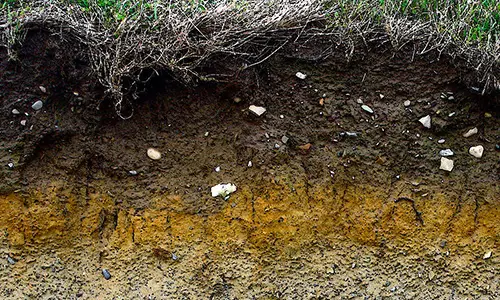• What is Soil?
A soil is what we always have under our feet while walking or what we are digging up if we are to plant something; it is the skin of the world. Soil is made up of different minerals, broken rocks, living organisms and decaying organic substance that we call humus. It also includes air and water, which living creatures are using to live underground. Soil has nutrients that the plant needs in order to grow.
• Soil Surveying
Soil surveying is where scientists observe and watch a certain area of soil. They study the soil’s moisture, type, and temperature in order to get proper details in that area. Soil surveying is only one way to study soils.
• Soil Erosion
Soil erosion is an environmental problem that causes soil to reduce quality over time; one of the main problems of agriculture, it is the reason why people abandon their agricultural lands. Soil erosion, caused by wind and water forces, washes the soil and its nutrients away, making soil much less fertile.
• Earthworms
The earthworm actually help farmers to fertile the soil. One of its abilities is vertical burrows or moving vertically under the ground; the trail left behind by earthworms was can help water to flow easier to its roots. Turning eaten leaves into fertilizer is another ability of these worms to have healthier soil.
Different Types of Soils
• Sandy Soil – It is the largest soil particle, ranging from 0.05 to 2mm, but only allows water to slip right through despite being the largest.
• Clay – Clay is made up of silicon, oxygen, and aluminum. It is the smallest soil particle at .002 mm and can hold high capacity of water. Many plants can thrive with soils which have huge amount of clay.
• Silt Soil – Another type of soil that has the size of .002 to .05 mm and are usually find in floodplains and waterways. Silt soil is a middle class of soil which has average amount of nutrients and drainage capabilities.
There are different layers of soil also referred as horizons:
• A Horizon – This layer of soil can be found at the uppermost part and what most of people call as topsoil; but natural disasters like volcanic eruptions and flooding can bury the A Horizon. A Horizon usually have dark colored soil which means that it contains more nutrients compared to other layers or horizons.
• B Horizon – A zone of accumulation, B Horizon commonly contains clays, iron and/or soluble salts; these materials are most likely to be transformed into soil. B Horizon is usually under the A Horizon but due to some reasons like renovation and erosion B Horizon can also be found at the surface.
• C Horizon – Also known as “saprolite”, the layer with parent materials such as glacial till or lake sediments, and it is also the horizon that is nearly unaffected by weather, thus keeping its parent materials to be unchangeable..
• O Horizon – Another surface horizon like the A Horizon, this horizon possesses at least 20% or organic materials by mass. It possesses natural decomposing materials such as leaves, dead grass, twigs, and branches. These horizons are typically black or dark brown in color.
• R Horizon – This horizon is what so called the bedrock. It is usually composed of sandstones, limestone, and/or granite. It is the lowermost layer of the soil.
• E Horizon – This is the place for leaching. There is a process for the E Horizon, which is called “losses”, which is why this horizon is light in color and sandy.











Leave a Reply